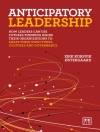Marketing Strategy: The Thinking Involved is an innovative text that promotes the idea that effective marketing thinking leads to successful marketing strategy. The book′s theories go beyond simply introducing the reader to concepts in the field by providing tools and methods to develop marketing thinking and questioning skills that will help with application of real-life marketing strategies. As the chapters progress, the thinking/questioning develops toward higher levels and more specialized inquiry, helping readers acquire the skills needed in the practice of marketing. The book′s timely focus on developing thinking agility leading to strategic agility provides the necessary skills for navigating businesses in today′s dynamic markets. The book contains a wealth of pedagogy to support this active learning approach.
Innehållsförteckning
Preface
The Difference – Becoming a Marketing Strategist
Decompression Exercises – Preparing the Way for Thinking
The Marketing Terrain Coverage
I. The Role Marketing Thinking Plays in Strategy
1. Marketing Thinking
Chapter Introduction
Marketing Thinking
Marketing Thinking and Effective Strategy
Marketing Thinking: 4-Dimensional Spherical (4-DS) Thinking
Learning to Think in a Marketing Way
Summary
2. Learning to Think in a Marketing Way
Chapter Introduction
The Process of Appropriation
Marketing Thinking in Practice: Shifting Times – The Muji Experience
Marketing Thinking in Practice: Taking the Sleeping Business to a New Level – Sleep Squad Comes to You
Strategy as a Question
Obstacles to Marketing Thinking
Summary
II. Thinking Through the Marketing Process
3. The Big Questions: Assessing the Situation
Chapter Introduction
The Significance of the Situation Assessment to Strategy
Questioning Techniques Applied to the Situation Assessment
Thinking about the Five Forces Model
Strategy Canvas and the Four Actions Framework
Other Related Considerations – Changes in Information
Summary
Case: Jet Blue – Customers Matter
4. Thinking Further about Marketplace Structure and Strategy
Chapter Introduction
Market Structure Orientations
Who is Segmenting the Market – the Marketer or the Consumer?
Traditional Marketing Logics and Their Sequential Role to Developing Strategy
The Problems of Not Recognizing the Position of the Questions Being Considered (Up- vs. Down-Stream Marketing Questions)
Segmentation Questions
Positioning Questions
Issues with the SPOT Marketing Perspective
Self-Selection Segmenting Questions
Marketing Thinking in Practice – Predictive Analytics
Summary
Case: Red Bull – What Does the Future Hold?
5. Thinking Through Difference – The Nature of the Marketplace and Consumption
Chapter Introduction
A Difference Perspective of the Marketplace
Marketing Thinking in Practice – The Global Crisis
Difference Perspective of Consumers
From a Difference Perspective – The Role of Strategy
Marketing Thinking in Practice – Nestle
Marketing Thinking in Practice – Strategic Collaboration Options
Summary
Case: Apple, Inc. – The Need to be Different
6. Thinking through the Marketing Mix
Chapter Introduction
Marketing Mixes
Marketing Thinking in Practice – Barnes & Noble′s E-Commerce
Issues with the Marketing Mix Concept
Marketing Thinking in Practice – Collaborative Marketing
Alternative Views to Consider
Thinking Strategies to Maneuver Around the Concept Obstacle
Summary
Case: Ally Bank – The Bank that Wants to be Your ’Trusted’ Friend
7. Co-creating Meaningful Differences with Products and Services
Chapter Introduction
The Meaning Generation Process – Creating Differences
Transitional Thinking – From Quality to Innovation and Beyond
Creating Value through Prices
Marketing Thinking in Practice – How Online Brand Communitiies Work
Strategy Considerations
Summary
Case: In-N-Out Burger – Keeping it Simple
8. Co-creating (Co-marketing) Meaningful Differences with Marketing Communications
Chapter Introduction
Traditional vs. Contemporary Forms of Marketing Communications
An Alternative to the Persuasive Orientation
Co-marketing Communication Strategies
Marketing Thinking in Practice – Ford Fiesta
Summary
Case: Alessi – Open Innovation
9. The Changing Customer Interface Landscape
Chapter Introduction
Re-thinking the Front Office
Marketing Thinking in Practice – The Service Interface
Customer Interface Changing Technology
Co-marketing: Co-creating an Experience
Creating ’Value’ – An Expanding View
The Consumer Experience – Strategy Considerations
Summary
Case: The Four Seasons Hotel & Resorts: Getting it Right
10. Thinking Beyond Logistics
Chapter Introduction
Thinking through the Channel Concept
Marketing Thinking in Practice: The Value Chain
Forms of Collaborative Distribution
Summary
Case: Zara Retailing – What′s on the Shelf Today?
11. The Question of Price
Chapter Introduction
The Origins of Price
The Strategy Role of Price
Marketing Thinking in Practice – Raise Your Prices!
Price Determination
Summary
Panera Bread Company – Believing in Reciprocity
III. Reflective vs. Forward-Looking Sides of Marketing Thinking
12. Assessment vs. Navigating Strategy – Using Metrics
Chapter Introduction
The Backward-Looking Perspective and Rear-View Metrics
Marketing Thinking in Practice: Rear-View Metrics
The Balanced Scorecard Perspective
The Forward-Looking Perspective and Metrics
Differences between Assessment and Navigating
Summary
Case: Best Buy – Looking Forward – A New Way
IV. Thinking Organization
13. Cultivating a Thinking Culture
Chapter Introduction
Organizational Cultures
Barriers to Organizational Thinking
Marketing Thinking in Practice: Creativity is the New Style in Leadership!
Characteristics of Thinking Organization
Summary
Case: Google, Inc. – Seeking the Fun in Innovation
Om författaren
Mark E. Hill is an Associate Professor of Marketing at Montclair State University with more than 20 years of academic and professional experience. He has taught graduate and undergraduate courses in Marketing Strategy, Marketing Research, and Consumer Behavior, and has published numerous articles on subjects related to marketing thinking. In 2006, he was honored with the Best Article for 2001 award by the journal of Marketing Education Review on “Teaching and Effectiveness: Another Look, ” at the 2006 Society for Marketing Advances Annual Conference. While Dr. Hill’s research provides the academic foundation of Marketing Strategy: The Thinking Involved, it is a culmination of his years of teaching, observing students, and listening to what employers are looking for from graduating marketing students that led to his interest in developing a different approach to teaching marketing. He received his Doctorate degree in Marketing from Southern Illinois University and has an MBA and a Bachelor’s degree in Mechanical Engineering. Prior to his academic career, Dr. Hill worked as an Aerospace Engineer for General Electric, a Technical Manager for American Airlines, and a Marketing Representative for Unison Industries. He has been a consultant to companies across the United States, providing services in the areas of marketing research and marketing strategy.












